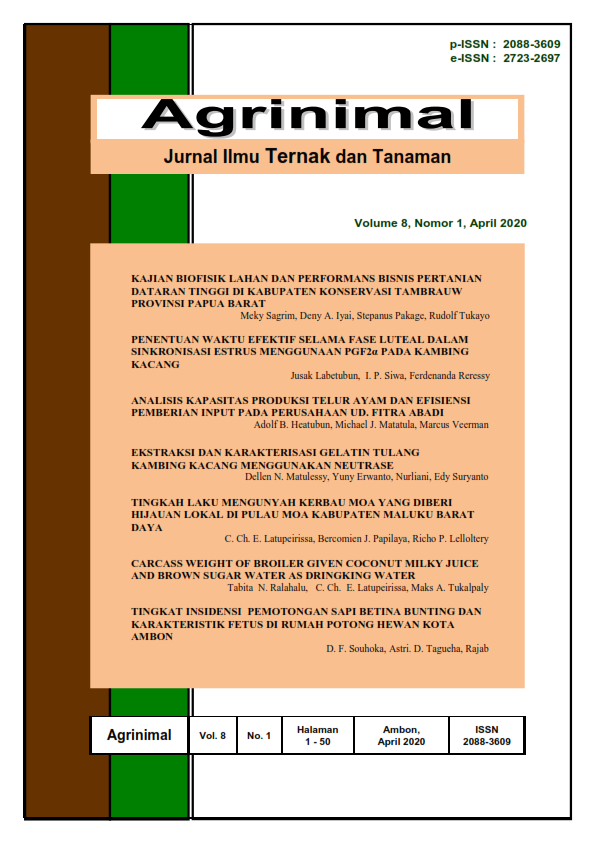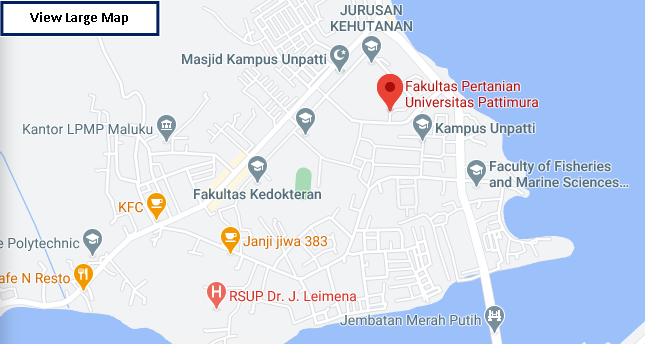ANALISIS KAPASITAS PRODUKSI TELUR AYAM DAN EFISIENSI PEMBERIAN INPUT PADA PERUSAHAAN UD. FITRA ABADI
Abstract
Egg production activities require the ability of Farmers or Farm company managers to control the amount of production produced, given the amount of production produced is a function of the inputs used. Each type of input has a certain capacity that is contributed at the level of production. Inaccuracy in controlling the production function can cause the production level to be not optimal, the use of the number of inputs is not optimal and inefficient. This study aims to analyze the egg production capacity produced related to the use of animal feed inputs. The study was conducted at the laying hens company UD. Fitra Abadi, and data were collected during October 2018. The sample used was one cage block with 2,100 hens laying hens. The results showed the capacity of laying hens as a permanent input on the U.D. Fitra Abadi is still low, namely production is only 26.19%. The shop food, corn feed, and bran feed are positively related to egg production. But statistically only shop food that significantly affect egg production, while the other two feeds are not significant. The capacity of the three inputs used is smaller than one (inelastic), but the capacity of shop food is greater than the other two feeds. The company needs to reduce the feeding of corn and bran and to prioritize giving full shop food to get the maximum amount of production.
Downloads
References
Abebe, T. H. 2019. The Derivation and Choice of Appropriate Test Statistic (Z, t, F and Chi-Square Test) in Research Methodology. Journal of Mathematics Letters. 5 (3): 33-40.
Afandi, R., H. Budi, dan H. D. Irfan. 2016. Karakteristik Penggunaan Dua Jenis Pakan terhadap Performa Produksi Ayam Ras Petelur di Kabupaten Blitar, Jawa Timur. https://journal.ugm.ac.id/buletinpeternakan/ article/download Supp File/24288/1646. [2/03/2020].
Du. N., Q. Shao, and R. Hu. 2019. Price Elasticity of Production Factors in Beijing’s Picking Gardens. Sustainabi-lity Journal. Vol. 11: 1-16.
Gujarati, D. N., dan D. C. Poter. 2010. Dasar-dasar Ekonometrika. 5th edition. New York: McGraw-Hill.
Izekor, O. B., and G. O. Alufohai. 2014. Production Elasticities, Return to Scale and Allocative Efficiency in Yam Production in Edo State, Nigeria. Agrosearch. 14(2): 179-190.
Kim, T.K. 2015. t-Test as a Parametric Statistic. Korean Journal of Anesthesiology. 68(6): 540-546.
Latan, H., dan T. Selva. 2013. Analisis Multivariate. Teknik dan Aplikasi Menggunakan Program IBM SPSS 20.0. Bandung: Alfabeta.
Mishra, S. K. 2007. A Brief History of Production Functions. Munich Personal RePEc Archive (MPRA).
Paul, J. 2019. Does Marginal Productivity Mean, Anything in Real Economic Life?. Munich Personal RePEc Archive (MPRA).
Yadaf, P., and C. S. Marwah. 2015. The Concept of Productivity. International Journal of Engineering and Technical Research (IJETR). 3 (5): 192-196.
Supranto. 2001. Statistika, Teori dan Aplikasi. Edisi Keenam, Jilid 2. Jakarta: Erlangga.
Syverson, C. 2011. What Determines Productivity?. Journal of Economic Literature. 49 (2): 326-365.








